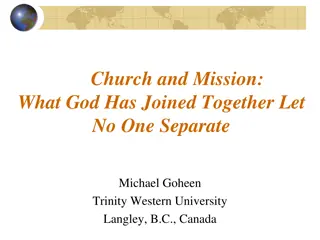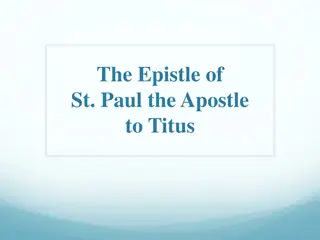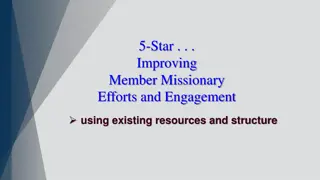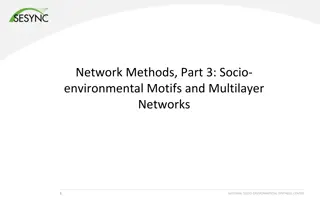Understanding Medical Missionary Work in Socio-Cultural Context
Living in a time of lifestyle diseases, it is crucial to understand the significance of medical missionary work in addressing health issues, combining soul and body care. Exploring the socio-cultural milieu, this conference emphasizes learning from Christ's people-centered approach to reach those in need, reflecting true ministry values from Ellen G. White.
Download Presentation

Please find below an Image/Link to download the presentation.
The content on the website is provided AS IS for your information and personal use only. It may not be sold, licensed, or shared on other websites without obtaining consent from the author. Download presentation by click this link. If you encounter any issues during the download, it is possible that the publisher has removed the file from their server.
E N D
Presentation Transcript
MEDICAL MISSIONARY CONFERENCE MARCH 9 11, 2012 TOPIC: MEDICAL MISSIONARY WORK: UNDERSTANDING THE SOCIO-CULTURAL MILIEU By Susan J. Chand, Phd (Medical Anthropology) Chair & Assistant Professor, Department of Sociology and Social Work, School of Social Sciences, USC.
Quotation Man is the crowning work of all that God has made. The proper study of every learner is man. Science, true and unadulterated, in all its achievements, is to be laid at the feet of the God of science. Man is a being to be prized. (Manuscript Releases, Vol.3 p. 335)
Outline What is Medical Missionary Work? Understanding the Socio-Cultural Milieu Ethnomedical practices in Trinidad and Tobago Anthropological model for Medical Missionary Work Christ s model for Medical Missionary Work
Introduction We are living in an era where life- style diseases are escalating in the present generation. Feeding on fast foods and dependency on medical drugs even for minor ailments have taken precedent over the nature s remedial ways. People have departed far from the health model given in the Bible and the pattern exemplified by Christ s life on earth. Thus, Medical Missionary Work is the need of the hour.
What is Medical Missionary Work? According to Ellen G. White (1952), Medical missionary work is the pioneer work of the gospel, the door through which the truth for this time is to find entrance to many homes. God s people are to be genuine medical missionaries, for they are to learn to minister to the needs of both soul and body. The purest unselfishness is to be shown by our workers as, with the knowledge and experience gained by practical work, they go out to give treatments to the sick. As they go from house to house they will find access to many hearts. Many will be reached who otherwise never would have heard the gospel message. (Welfare Ministry, p.125)
Understanding the Socio-Cultural Milieu Christ s medical ministry on earth was people-centered. He reached out to people where they were: Homes Streets Market-places Synagogues Cities By the Sea In the fields In the graveyards
Quotations of Mrs. E. G. White True Ministry: Need to approach people To reach people Whatever their position or condition Learning from Christ s methods of labor and His meeting of people Wherever they are In Humbling our hearts before God Acceptable manner To help them every possible way.
Culture and Society Culture Society Know- ledge habits art Interacting Individuals Belief Capabi- lities law custom morals
Concepts of Health and Disease DISEASE Promotive H E A L T H Preventive Deviance from Health Curative
Disease, Illness & Sickness Disease: refers to a scientifically identified health threat caused by a bacterium, virus, fungus, parasite, or other pathogen. (medical concept) Sickness: is a blanket term given to events involving disease and illness. (a social construction of disease and illness) Illness: is a condition of poor health perceived or felt by an individual who is said to be ill. (cultural concept)
Disease, Illness & Sickness According to Young (1982), Disease is what a medical professional would label as disordered physiology, whereas, illness refers to perceptions and experiences of certain disvalued states of the affected persons who is said to be ill . Thus, it can be said that disease is a pathological condition of the body whereas illness is a cultural concept. Eisenberg (1977) states that patients suffer illness ; physicians diagnose and treat disease . Moreover, a medical doctor wishes to cure disease but he treats illnesses, for it is usually the impairment of function and not the presence of disease pathogens that cause us to seek aid . (Foster and Anderson, 1978, p.40)
Disease, Illness & Sickness In this context, sickness is defined as a process for socializing disease and illness (Young, 1982, p.270). Thus, Sickness is community members perception of persons suffering from illness. So, a sick person (as viewed by the community members) lives both with the symptoms and consequences of disease in its physical and mental, medical and social aspects. In the act of alleviating his/her disease, the sick person becomes involved in numerous specific or non-specific, internal or external problem solving processes (health-seeking behavior). In this process, persons may follow prescriptive medicine or adhere to natural remedies (whichever works best for them and which is defined to them by their societal norms).
Socio-cultural Interpretation of Medicine Medicine can be interpreted from two aspects: Biomedical which interpret disease along the Germ Theory line. This interprets disease in terms of spiritual, cosmic, ancestral, supernatural, social, etc. These pathogenic agents/forces that intervene the human body are either driven out or pleased ritually with the help of socio- cultural procedures or ritually with the help of a medicine man. Socio- cultural
Concept of Ethnomedicine In the above context, Ethnomedicine or folk medicinecan be defined as those beliefs and practices relating to health and disease, which are products of indigenous cultural developments and not explicitly derived from conceptual framework of modern medicine (Hughes, 1968, p.99).
Concept of Ethnomedicine Ethnomedical practices refer to: Through traditional systems of medicine which include: All are rooted in the : Promoting health and longevity Socio-cultural context of a given community. Preventing disease and illness Magico- religious beliefs and practices Use of medicinal plants physiotherapy
Ethnomedical Practices in Trinidad and Tobago (Historical Background) Chinese & Indians were brought to Trinidad and Tobago as indentured laborers to work in plantations Spanish Africans French British Amerindians came by canoe to Trinidad and Tobago from the Orinoco delta were looking for gold were abducted by slave traders were displaced by French Revolution and by the capture of other Caribbean Islands by the British came with the colonial establishment;
Ethnomedical Practices in Trinidad and Tobago In essence, the Caribbean folk medicine in its wider context is the marriage between: European folk medicine Amerindian folk medicine Scientific medicine Chinese-based medicine African-based practices Indian-based medicine
Ethnomedical Practices in Trinidad and Tobago Ethnomedicine or Folk medicine is called Bush Medicine in the Caribbean. It includes: home remedies folk etiologies of disease, preventative medicine medicinal properties of plants reproductive techniques anatomical knowledge Magico- religious practices physiotherapy healers
Doctrine of Signatures The Doctrine claims that features made by God identify the plant with a specific disease or part of the body or more simply like cures like (Sofowora, 1982; Etkin, 1988). For example, plants with heart-shaped leaves are good for treating heart diseases; plants exuding milky juice are believed to increase lactation in women. In India, a plant with kidney-shaped leaves (Centella asiatica) is used for treating kidney and liver ailments.
Centella Asiatica Common name: pennywort
Doctrine of Signature Signature plants were probably first recognized in ancient China, where there was a classification that correlated plant features to human organs. yellow and sweet = spleen red and bitter = heart green and sour = liver black and salty = lungs
Chinese-based medicine Yang (primitive male) was associated with strongly acting plants; ailments of the upper half of the body were treated with upper parts of plants. Yin (primitive female) was associated with plants having moderate action and those with bitter, sour, salty, and sweet tastes; ailments of lower parts of the body were treated with below-ground plant parts.
Quotation The fruit thereof shall be for meat, and the leaf thereof for medicine. Ezekiel 47:12. Moringa oleifera Common name: saigan
Concepts of Hot and Cold in Ethnomedicine Hot Cold Neutral processed starch food, all flour-based foods (dumplings, dalpuri/roti), cornmeal-based foods, rice, spices and condiments (seasonings), garlic, lemon grass, tea infusions. There is a common belief that any food that cause constipation is considered to be hot. Thus, it should be balanced by consuming cold foods. all fruits and green vegetables especially those which are high in fiber, fruit juices, bush tea . Cold foods are believed to alleviate constipation and allow free bowel movements. One feels refreshed when consuming cold foods as it cleans the bowels. legumes, tubers (all ground provisions dasheen, eddos, yam, sweet potatoes, potatoes, etc), starchy fruits. Neutral foods can be combined with any hot or cold food and consumed.
Bush Tea It is interesting to note that bush tea is considered as both hot and cold drink and is a popular natural remedy for illnesses considered as cold (all respiratory ailments) and hot (pressure due to improper diet too much starchy foods; stress or drinking; fever). Bush tea is generally prepared as infusions from fresh or dried leaves from the plants or herbs growing in their backyards (mint, basil, guava, sour sop, periwinkle, blue vervain, orange leaves and lemon grass). Blue vervain, lemon grass and guava leaves
Stachytarpheta jamaicensis Light blue snake-weed, Blue porterweed. Native throughout the Caribbean. The fresh leaves are consumed in bush tea as a cooling tonic and blood cleanser, to treat asthma and ulcerated stomachs .
Creolization of Medicine The process of integrating western medicine into the folk medicine is often termed as Creolization of medicine. It has a global approach and people utilize all available health care alternatives in a pragmatic way. . Preventive medicine is practiced by keeping the body in balance through proper use of diet, drinking bush teas to help keep the blood clean and keeping the hot-cold balance by avoiding certain behaviors or situations like taking a bath when the body is hot(Hill, 1985).
Creolization of Medicine the treatment begins with an individualized prevention of illness ends with a specialized therapy.
Creolization of Medicine The process of elimination in the diagnosis of the illness is an important aspect of Creole medicine. When home remedies fail Home remedies When biomedical treatment fails Specialists are consulted Biomedical treatment
Significance of number 9 in Folk Medicine Among Amerindians Among Roman Catholics Among Hindus 9 days of mourning nine-night wake before the burial of the dead novenas or nine days/nights of prayer 9 days of fasting and festivity before diwali
Amerindian-based Knowledge It is from the Amerindians comes the use of plants to excite dogs to hunt. Other aspects are rituals that include tobacco, and the significance attached to dreams. The intoxication of fish before capture is considered to come from Amerindians. The use of Lignum vitae for women s problems and sexually transmitted diseases has Amerindian origins. The practice of couvade.
African-Based Knowledge Personalistic explanations of sickness of African origin are classified under the term Obeah. An Obeah man is sought for illnesses caused or influenced by another human. Obeah includes healing as well as a whole range of magic that is used for success in love, career and harming enemies. Obeah is associated with male practitioners, can be counteracted by another practitioner, by the use of talismans or by Catholic prayers. Theretia nerifolia (yellow oleander), Abrus precatorius (rosary pea), Hippomanemancinella (poison apple), Nerium oleander (oleander) have associations with obeah and can only be cut at certain times of the moon. Obeah man in Jamaica
Plants used in Obeah practice Yellow Oleander
Indian-based Knowledge The types of healers found among East Indians are Vaidyas , Ojhas and masseurs . The Vaidyas are the physicians using medicinal plants for treatment. Their medical knowledge is derived from the Ayurvedic system of medicine. Ojhas (Hindu pundit or Muslim Imam), have magico-religious forms of healing. They resort to jharay or shaking away the illnesses or evil eye spell by waving a leafy branch of Neem or cocoyea broom. The masseurs provide more a physical healing called cracking , rubbing , and vein pulling . They also have a special ability to massage away pains affecting the muscular and skeletal system.
Indian-based Knowledge Cocoyea broom used for jharay Ayurvedic medicine
Anthropological Model for Medical Missionary Work Internalization of the health message will transform lives. Make health message a reality and acceptable component of their local culture. Identify the positive aspects of the Ethnomedical practices and strengthen/re -enforce them Use local terminologies to present the health message Find an entry point in the local culture to present the health message Understand the local cultural health beliefs and practices
Christs Model for Medical Missionary Work Make Christ s work your example. Constantly He went about doing good feeding the hungry and healing the sick. No one who came to Him for sympathy was disappointed (Welfare Ministry, 53). Be a living example Approach in the socially acceptable manner Approach with humility and prayer Christ's example Meet people where they are
Quotation According to Ellen G. White, Genuine medical missionary work is bound up inseparably with the keeping of God s commandments, of which the Sabbath is especially mentioned, since it is the great work of restoring the moral image of God in man, this is the ministry which God s people are to carry forward at this time (Testimonies to the Church, Vol.6 p. 266).
Conclusion In conclusion, let us join us hands together in moving the Medical Missionary Work ahead and prepare souls for Christ soon return.
References Lans, C. (2007). Creole remedies of Trinidad and Tobago. (ebook) Quilan, M. B. and Quilan R. J. (2005). Balancing the system: Humoral medicine and food in the Common Wealth of Dominica. In Eating and Healing: Exploration of Wild and Domesticated Plants and Animals as Food and Medicine by A. Pieroni and L. Price (Eds). NY: Haworth Press. Thio, A. (2009). Sociology: A brief introduction (7th Edition). NY:Pearson. White, E. G. (2002). The Medical Missionary Manual: A compilation from the writings of Ellen G. White. (ebook)
My Prayer for You Beloved, I wish above all things that thou mayest prosper and be in health even as they soul prospereth ( 3 John 2)























